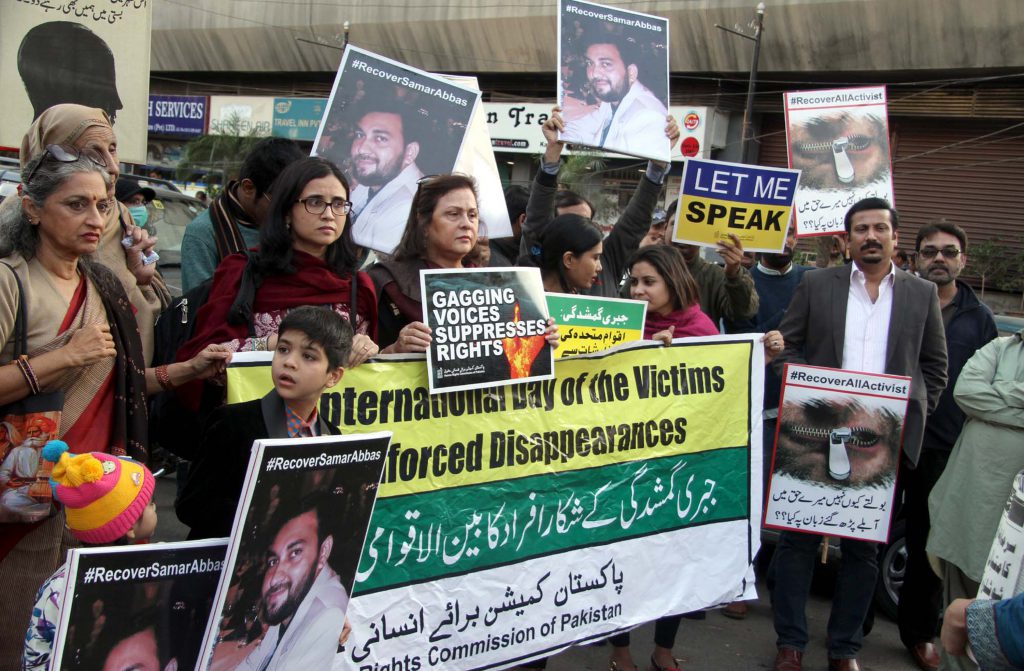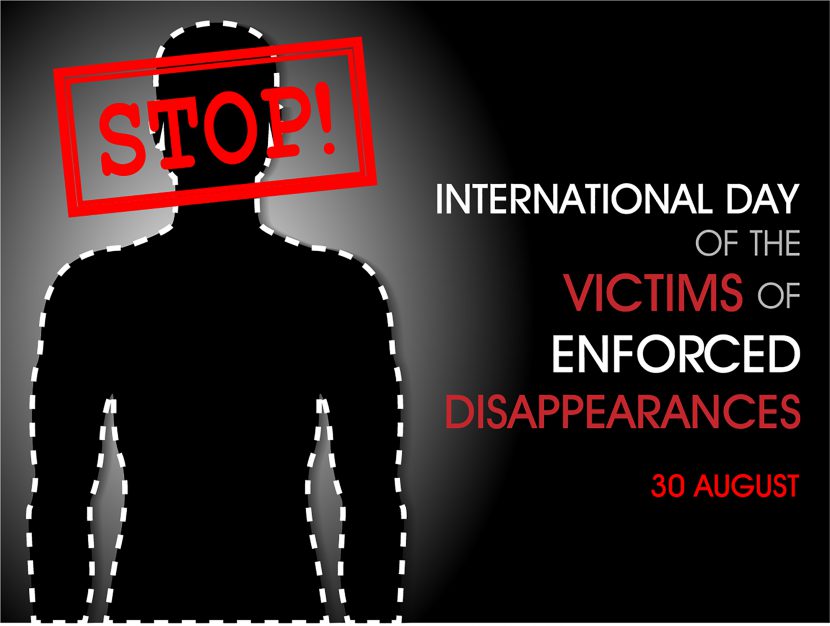People look for their families for their whole lives. They themselves go missing in the search. This horrific violation happens alongside abuses of torture, coerced confessions, sexual assault and murder; and exacts untold torment upon its victims and survivors.
What is Enforced Disappearance?
“Enforced disappearance is the abduction of a person with the acquiescence of the Government followed by refusal to disclose the person’s fate or whereabouts” (United Nations, 1993). International Day of the Victims of Enforced Disappearances on 30 August is a day of awareness and commemoration held annually by the United Nations.
What this can look like is the arrest of an individual by state actors, without a warrant, without rights, charges or an explanation given. There is a refusal to provide any information whatsoever. The person is taken by said actors and never seen again.
Enforced disappearance is used as a tool of systemic oppression of communities considered as politically dissident. A knock-on effect ripples across relatives since enforced disappearance is frequently enacted as reprisal upon the loved ones of the targeted individuals.
Where does Enforced Disappearance Take Place?
Enforced disappearance happens all over the world. It takes place on every continent with Latin American states such as El Salvador, Argentina and Peru being particularly affected, alongside other countries that have experienced conflict or social upheaval such as Syria, Iraq, Kosovo, Western Sahara, Pakistan and Egypt, among many more. In 2014 the United Nations Working Group on Enforced Disappearance had 24, 250 reported unresolved cases across 88 states (United Nations, 2014).
Another example is Colombia, where there are 150,000 registered forced disappearances between 1986 and 2017. A further study has demonstrated that as many as 80,000 people (almost 50% of those disappeared) are still missing today in Colombia, and are feared murdered during the armed conflict. The true figure, however, will never be known. Often it is unclear who disappeared these victims and why (Colombia Reports, 2019).
The Word of International Law
International law’s cornerstone mechanism on enforced disappearance is the International Convention for the Protection of All Persons from Enforced Disappearance, which stipulates the irrevocable and extensive illegality of enforced disappearance without exception (United Nations, 2019). Unfortunately, however, only 59 states have to date ratified this convention (UN Treaties, 2019).
Other legal mechanisms include those such as the Inter-American Convention on Forced Disappearance of Persons and the Rome Statute of the International Criminal Court. The Statue, like the Convention, declares that enforced disappearance is a crime against humanity.
One of the things that make enforced disappearance so dangerous is that it takes its victim outside of all rule of law and legal mechanisms, thus depriving them of their rights and existence as a subject under the law. State sanctioned unlawful vanishment leaves individuals no recourse to justice and no access to protection, redress or reparation.
Enforced disappearance tends to violate economic, social and cultural rights as well as being in contravention of numerous human rights enshrined at the heart of customary international and national law and treaties. These include the right to recognition as a person; the right to liberty and security; the right not to be subjected to torture and other cruel, inhuman or degrading treatment or punishment; the right to life, the right to an identity; the right to a fair trial and to judicial guarantees. It constitutes a crime against humanity (United Nations, 2019).
Consequences in Families, Communities and Hearts
The forced disappearance of a child or their parent is a serious violation of the rights of the child enshrined in the Convention of the Rights of the Child.
Those who are themselves victim to enforced disappearance suffer from being in constant fear for their lives. They are often tortured and killed. On the rare occasion a victim is released from capture, long-term psychological and physical consequences of the dehumanising brutalisation which they endured often remain.

Countless lifetimes are spent without receiving answers as to the fate of disappeared loved ones. ‘Closure’ can be incredibly complicated or impossible to obtain. Some psychologists recommend families conduct burials of objects that were meaningful to the disappeared loved one, in order to allow them to begin a grieving process (Martín Beristain, 2010).
Families and friends are made to suffer indefinite mental anguish, often passing their lives never knowing the fate of their loved one, whether they are alive or dead, what condition they are in, what treatment they are subjected to, or where they are. Alongside this torment, family members are often aware of being at high risk of disappearance themselves. Searching for the truth is likely to endanger them even further as they may become subject to reprisals and be disappeared as well, creating a heartbreaking circle.
Furthermore, the disappeared person is often the main breadwinner of their family unit, meaning that the material and economic impacts of their absence are considerable. Women tend to be the ones most affected by the economic hardship created by enforced disappearance and are at ‘the forefront of the struggle to resolve the disappearance of family members’ (United Nations, 2019). The search for loved one itself incurs significant costs and the lack of a death certificate or any concrete proof or conclusion as to the fate of their family member makes it extremely difficult to access state support, compensation and services including pensions.
Taking the decision to declare a family member dead, even after many years (whether it be an economic necessity or not) is something immensely painful. The relative can feel as if they themselves are the one to ‘kill [their] loved one in [their] mind’ (Martín Beristain, 2010). Some countries such as Argentina and Chile issue certificates for those enforceably disappeared which enable claiming of compensation; but even these can be complicated, slow and costly to obtain and can require a prerequisite death certificate (UN Commission on Human Rights, 1998).
Communities are fractioned and severely impacted by the practice of enforced disappearance which is often weaponized against large groups of people as a mechanism for spreading terror. The feeling of insecurity, fear and instability dissipates throughout communities and surrounding societies as a monumental disruption and dissemination of terror.
Humanium Condemns Enforced Disappearance
At Humanium we abhor enforced disappearance and everything it brings about. By working alongside local partners such as ‘Hand in Hand India’ and ‘Avsi’ in Rwanda we hope to contribute to the protection of children affected by the greatest vulnerability from such violation of their rights. With the 30th anniversary of the Convention of the Child’s Rights impending, at Humanium we renew our commitment to the promotion of children’s rights, whilst taking the opportunity to highlight phenomenons such as enforced disappearance that demonstrate the importance of such work. At the same time, we recognise how very very far there still is to go.
If you know of a child or young person affected by enforced disappearance, or whose rights have been violated, do not hesitate to contact the Humanium helpline, where we do our utmost to give tailored guidance and advice. Humanium’s close partner, Alliance des Avocats pour les Droits de l’Homme (AADH), works with us on helpline cases of child rights alongside other determined lawyers throughout the world with whom Humanium is connected.
Written by Josie Thum
Bibliography
Amnesty International, ‘Enforced Disappearance’ (2019), available at: https://www.amnesty.org/en/what-we-do/disappearances/, Retrieved 07 August 2019.
Carlos Martín Beristain, Manual sobre perspectiva psicosocial en la investigación de derechos humanos (Bilbao: Universidad de País Vasco, 2010).
Colombia Reports, ‘Forced Disappearances’ (2019), available at: https://colombiareports.com/forced-disappearances-statistics/, Retrieved 06 August 2019.
Human Rights Watch, ‘Families Beg for Answers on the International Day of the Victims of Enforced Disappearances’ (2018), available at: https://www.hrw.org/news/2018/08/27/families-beg-answers-international-day-victims-enforced-disappearances, Retrieved 07 August 2019.
Forbes, ‘The International Day of the Victims of Enforced Disappearances’ (2018), available at: https://www.forbes.com/sites/ewelinaochab/2018/08/29/the-international-day-of-the-victims-of-enforced-disappearances/#4be267b0b42e, Retrieved 08 August 2019.
OHCRH, ‘International Convention for the Protection of All Persons from Enforced Disappearance’ (2006), available at: https://www.ohchr.org/EN/HRBodies/CED/Pages/ConventionCED.aspx, Retrieved 08 August 2019.
OCHCRH, ‘Working Group on Enforced or Involuntary Disappearances’ (2019), available at: https://www.ohchr.org/en/issues/disappearances/pages/disappearancesindex.aspx, Retrieved 07 August 2019.
OCHRH, ‘Enforced or Involuntary Disappearances’ (2009), available at: https://www.ohchr.org/Documents/Publications/FactSheet6Rev3.pdf, Retrieved 07 August 2019.
Priya Pillali, ‘Enforced Disappearances: A Global Scourge, Increasingly Under the Radar’ (2019), available at: http://opiniojuris.org/2019/05/31/enforced-disappearances-a-global-scourge-increasingly-under-the-radar/, Retrieved 08 August 2019.
UN Committee on Human Rights, ‘Report of the Working Group on Enforced or Voluntary Disappearances’ (1998), available at: https://www.refworld.org/docid/3b00f53bc.html, Retrieved 06 August 2019.
United Nations, ‘International Day of the Victims of Enforced Disappearances 30 August’ (2019), available at: https://www.un.org/en/events/disappearancesday/index.shtml, Retrieved 06 August 2019.


